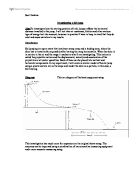Mechanics and Sport Performance
109685
Contents
Brief pg3
Main Text pg3
Appendix pg6
Reference List pg9
The aim of this assessment is to analysis the long jump technique by applying the following kinetic and kinematics principles: force, inertia, momentum, friction, Newton’s Laws, free body force diagrams and impulse-momentum relationships which underpin the mechanics of sport.
The long jump is a speed event which comprises of four phases: approach run, take off, flight through the air, landing. To achieve maximum distance in the long jump the athlete will have to balance three components - speed, technique and strength (Carr 1999).
The approach phase of the long jump as stated by Hays (1993) is to get the athlete up to the optimum position for take off with as much speed as the athlete can control during this part of the jump so the rhythm in the approach run is important to ensure the ideal speed is achieved at take off and also accuracy in hitting the take off board. The generation of the forward motion is created by a ground reaction force where the earths force is responding to the athletes backwards thrust against the earths surface (Carr 1997). The ground reaction force R is equal in action line and magnitude to the downwards thrust of the foot during running but in the opposite direction. The force is greater at the heel strike then at mid stance because of the body’s momentum and greater at push-off due to the plantar flexion thrust of the calf muscles driving the body forwards (figure 1) (LeVeau 1992). The force against the earth’s surface is at a slight angle as the athlete’s centre of gravity is slightly forwards. The law of inertia stated by LeVeau (1992) the body remains at rest until acted upon by an unbalanced force which is proportionate to the body’s weight. Most jumpers take a long third last stride which lowers the centre of gravity and by making the last stride relatively short (Figure 2) allows the hips to dip and drive up (Wirhed 1996). Hays (1993) states the transition from the approach to the take off is the most important part of the technique. The athlete makes body position adjustments in the last two strides of the approach in preparation for the take-off. Long jumper Bob Beamon benefited from the slight reduction in gravity and air resistance when he set the world record in Mexico City (short approach – short sprint). In higher altitude there is less air which is bad fro long distance runners as they have less oxygen in the air. In 1995 Ivan Pedrosa beat Mike Powell’s record in the high altitude of Italy which proves that there is an assistance of altitude which creates less gravity and wind resistance. The penultimate stride right before take off the jumper’s centre of gravity is lowered, the body id tilted backwards and the performer’s arms and free leg are positioned to the rear of the body Carr 1997). Lowering the body pre-stretches the muscles of the jumping leg causing an explosive thrust downwards at the earth (ground reaction force). The performer can spend longer over applying the force of the jumping leg by combining the lowering of the body with leaning back slightly. Swinging the arms forwards and upwards adds to the downwards thrust of the athletes downwards leg against the earth’s surface (Carr 1997).







